Experience Forest Therapy in Iowa This Winter
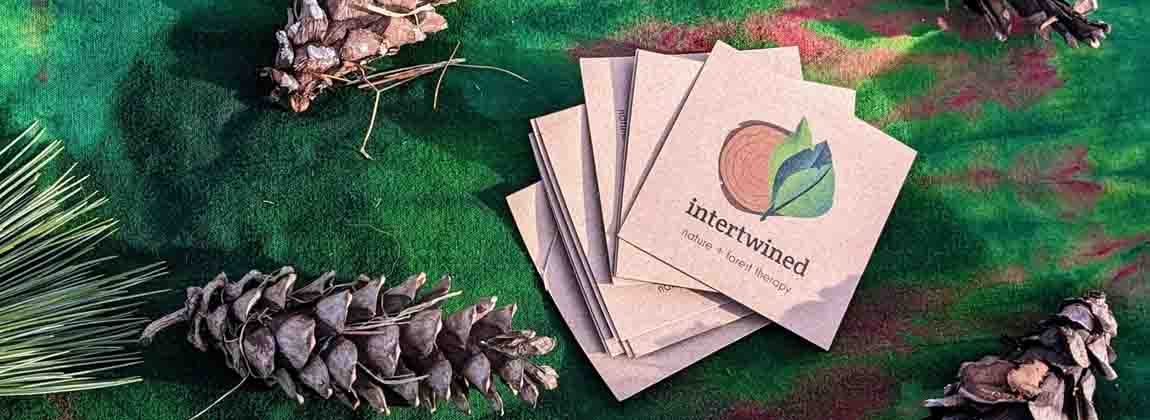
A Brief History of a Japanese Tradition: Forest Bathing
Nature is healing, and we’ve got thousands of scientific studies to prove it. In a world where stress has become a way of life, many of us are continually scrambling to find ways to shed it. We turn to meditation, yoga and regular sessions at the gym to help downregulate our hyper stimulated nervous systems. Less healthily, we might also turn to sugar, alcohol and other maladaptive behaviors to help us cope with the seemingly never-ending stream of pings, breaking news alerts and demands on our time and energy. Yet the most accessible method for lowering blood pressure and stress hormone production, for boosting immunity, reducing anxiety and improving mental health is the one that also happens to be free of charge: go sit outside in nature and take notice of what’s around you.
No one knows this better than the Japanese. In the 1980s, Japan’s already massive shift from a pre-war agrarian and manufacturing-based economy toward urbanization heightened during this so-called Dot.com era. Millions of Japanese workers settled in densely populated urban centers, working long hours indoors, in front of computer screens, as Japan’s economy rapidly transitioned to its focus on telecommunications and technology-based work. This cultural and economic shift did not come without consequences: Japanese society quickly fell into a health epidemic, as stress-related conditions like hypertension, depression and suicide all trended upward as people spent more time working long hours indoors in urban settings. “Karoshi syndrome” in Japan is literally translated into “death by overwork,” and the peak in cases of Karoshi syndrome coincided with this same decade.
What was, and continues to be, the anecdote? The Japanese government created an initiative to encourage workers to seek stress relief in nature — and in forests specifically, since 67% of Japan is covered in forested area. They called it Shinrin-yoku (which translates into “bathing in the forest atmosphere,” or “forest bathing” in English); an invitation for workers to get into green spaces as a form of stress management. Forests are believed to be not only healing, but time spent in forests also connects Japanese people back to the country’s traditional spiritual beliefs that nature is sacred.
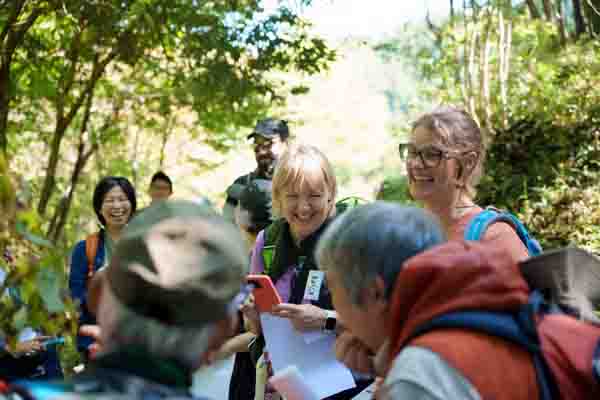
Brandy went to Japan in 2023 and traveled with other guides from around the world to experience Shinrin-yoku in the forests where the practice was born.
To bolster this initiative, the Japanese government funded scientific research that sought to explore how time spent in nature impacts human health. Here are just a few fast facts about how time spent in nature benefits our physiological and mental health (and these are only the tip of the iceberg!):
-
After spending 20 minutes in nature, individuals experience a 21+% per hour drop in the stress hormone cortisol (with 20-30 minutes being the sweet spot where the most significant drop in cortisol occurs). (Hunter et al. 2019, Frontiers in Psychology)
-
Memory & attention span boosted by 20% after 1 hour of walking & interacting with nature, (even if you do not enjoy it!) (Berman et al. 2008, Psychological Science 19(12):1207-12)
- Forest bathing significantly reduces symptoms of depression and anxiety by decreasing negative emotions and rumination. (Siah et al. 2023, Int J Ment Health Nurs)
By 2003, a quarter of Japanese citizens had already taken part in a Shinrin-yoku experience at one of the country’s 65 certified forest therapy bases and associated trails. While nature has clearly been a natural fit for stress management and healing in Japan, the good news is that you don’t have to go to Japan to enjoy the health benefits of nature. You can do so right here in Greater Des Moines (DSM).
What to Expect During a Guided Forest Therapy Walk
The Japanese philosophy of Shinrin-yoku has inspired the development of nature-based health and mindfulness practices all over the world, including the practice of forest therapy here in the United States. The Association of Nature + Forest Therapy (ANFT), based out of Prescott, Ariz., began a training and certification program in 2014 for guides seeking to offer this standardized, science-based practice to their own communities. Since then, ANFT has trained around 2,500 guides all over the world, including me. I trained and certified with ANFT in 2019 and have been guiding forest therapy walks as a small business owner in DSM over the past five years.
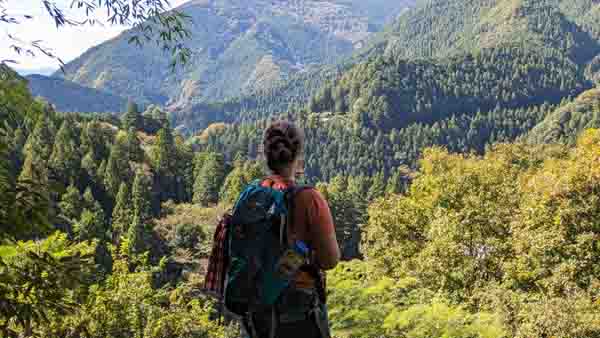
Brandy in Japan
Forest, or nature, therapy is a practice that can be enjoyed solo or in a group. It is an extremely accessible practice, suitable for any age or ability. Guided forest therapy walks typically engage a group, and participants can expect the experience to include solo wanderings in nature as well as shared time together as a group. A guided forest therapy walk is a slow, mindful experience that can take place in any natural setting, such as a woodland area, along the shoreline of a body of water, on a trail through Iowa prairie, in an urban public park or your own yard. These walks are typically between 2-3 hours long, although shorter experiences are sometimes offered to accommodate the audience or venue, such as for young children or to give individuals a taste of the practice.
Forest Therapy Guides are not therapists. As guides, we like to say that the forest is the therapist, and the guide opens the door. On a forest therapy walk, your guide will offer the group a series of invitations that are designed to encourage participants to engage with nature using their senses, cuing their brains to quiet and take a back seat to their bodies. Through the body, we become more present and grounded by tuning in to what’s really happening all around us; things that are easily missed when we are caught up in the cycle of stress and with a racing mind.
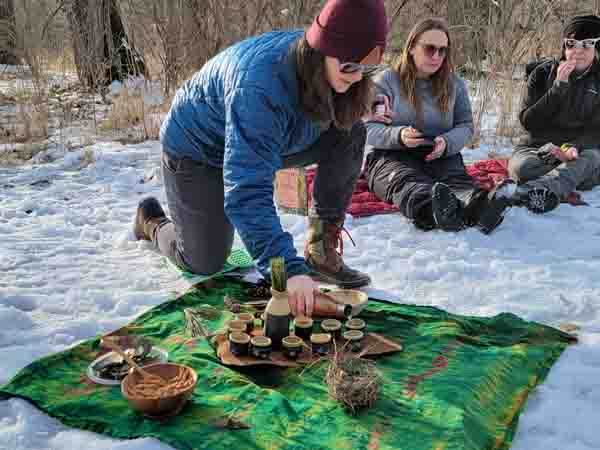
Forest therapy walks typically end with a tea ceremony. Here, Brandy pours tea after a winter walk.
Through Intertwined, I’ve had the honor of guiding more than 700 Iowans of all ages on forest therapy walks in the past five years. I guide walks all around the region in partnership with both Polk and Dallas County Conservation Boards, several different metro area City Parks and Recreation divisions, with the DNR, Greater Des Moines Botanical Gardens, Reiman Gardens, retirement centers and more. I love guiding custom walks for workplace teambuilding events, self-care retreats, conferences and school groups. Iowans of all ages need a break from anxiety and stress, and reconnecting to nature benefits not only our physical and mental health, but it can provide us with a sense of awe, and a reminder that the universe is bigger than we are (in a very good way!) The good thing is that forest therapy is a practice, and just like meditation or yoga, you can go forest bathing 1,000 times and have 1,000 different experiences.
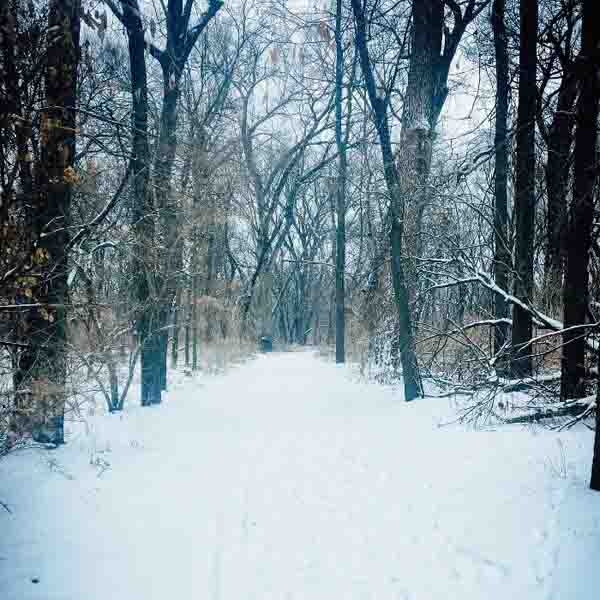
Winter Forest Therapy in Greater Des Moines
Forest therapy can be done all year round; don’t let winter keep you from getting outside! Especially in winter, when the days are shorter and darker, taking time to slow down and notice the beauty around you, getting outside for fresh air and sunshine, and finding ways to embrace all that nature has to offer you regardless of the temperature, can be so important. My guided winter walks often combine forest therapy with snowshoeing or locally-foraged tea around a fire. These experiences can be a wonderful way to enjoy the quiet, slower pace of wintertime.
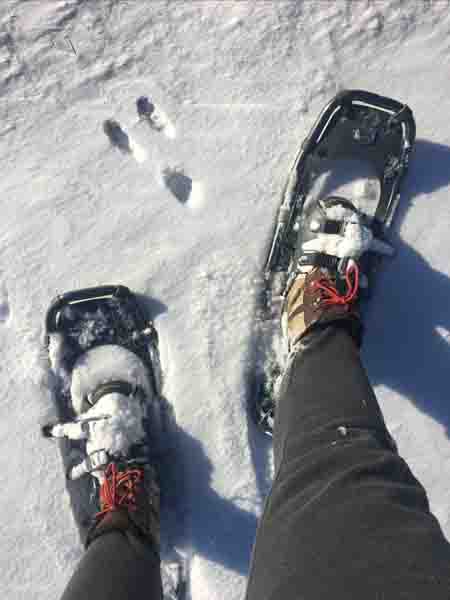
Maybe your New Year’s resolution for 2025 is to allow yourself more time for self-care. Maybe it’s to take up a new practice to aid in stress relief. Maybe it’s to get outside more. Maybe it’s to connect with others in a more meaningful way. If those sentiments ring true to you, I hope you will join me in 2025 for a guided forest therapy walk. I will offer two guided experiences listed in the month of January in DSM. The first will be on Saturday, Jan. 18, 2025 in partnership with Waukee Parks & Recreation at The Vineyard. The second will be on Saturday, Jan. 25, 2025 in partnership with Polk County Conservation at Jester Park, which includes a combination snowshoe + forest therapy experience. Many, many more guided experiences will be listed on my website throughout 2025 as they become available. The wonders and healing of nature in winter await you: I hope to see you there!
The Greater Des Moines Partnership calendar of events is a one-stop resource for activities taking place throughout the region. Find networking information for Greater Des Moines (DSM) businesses, including Chamber luncheons, roundtables and ribbon cuttings. You can also find live music happening each week thanks to the “Live Music This Week in DSM” blog series.
Brandy Case Haub
Brandy Case Haub, Certified Forest Therapy Guide, is the Founder and Owner of Intertwined: Nature + Forest Therapy. She received her training and certification through the Association of Nature + Forest Therapy in 2019. Intertwined offers guided nature therapy experiences to groups, individuals and organizations in Central Iowa.